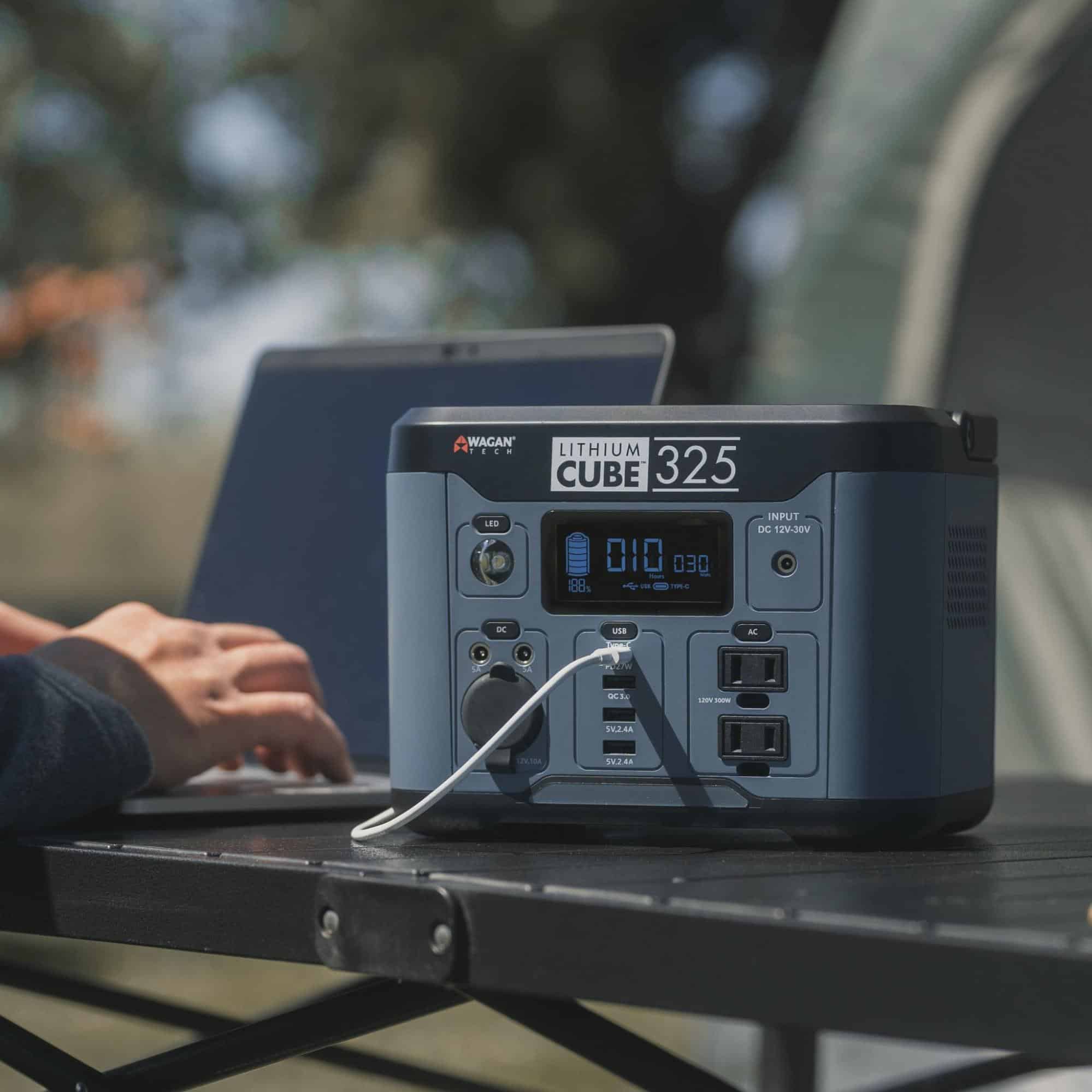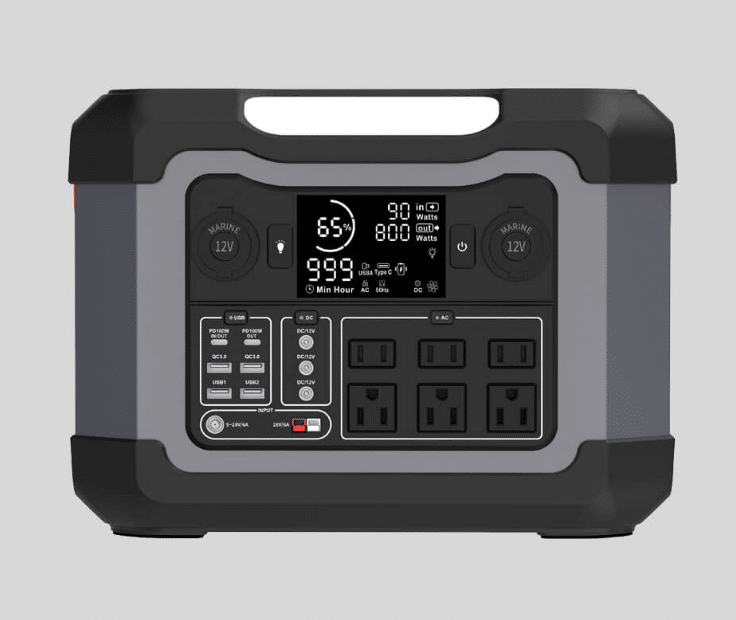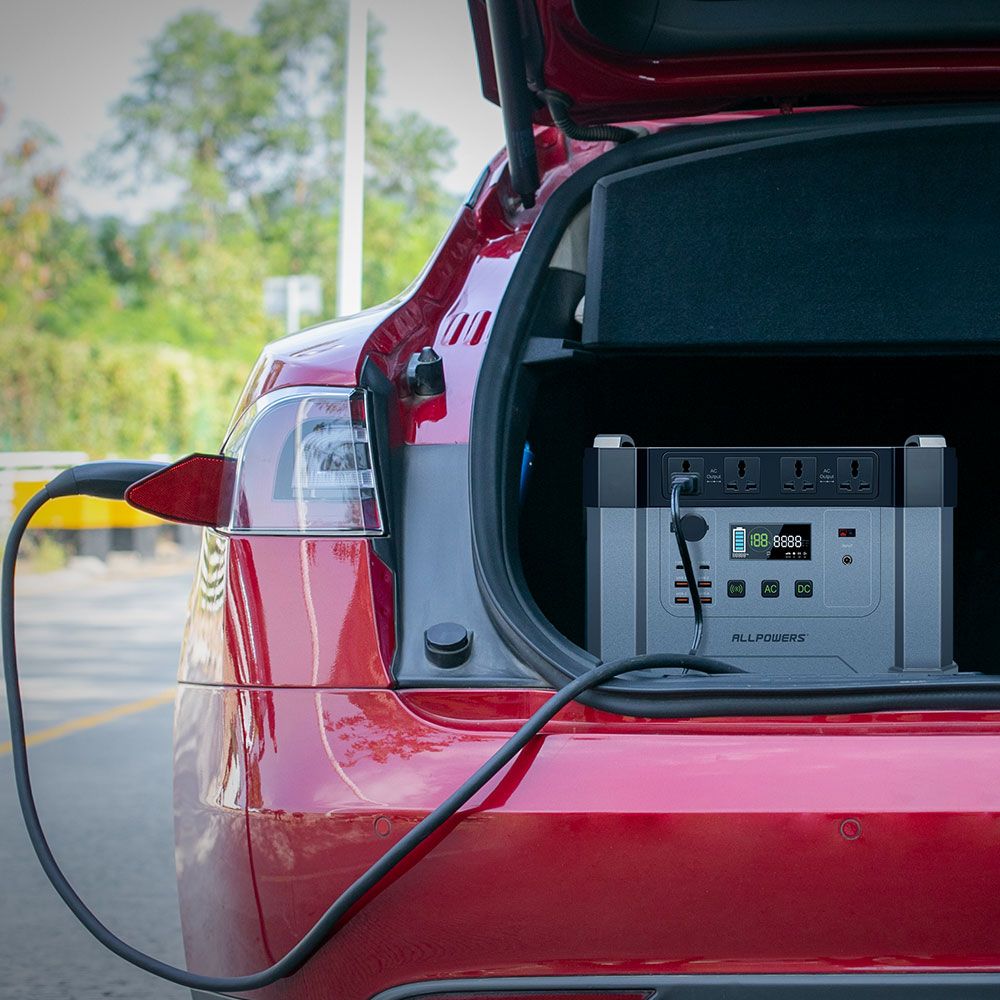Batteries wired in parallel vs. series are ubiquitous in various applications and industries, especially those involving lithium cells. Both of these mechanisms have their respective specifications and advantages that you can learn by reading this post from start to finish.
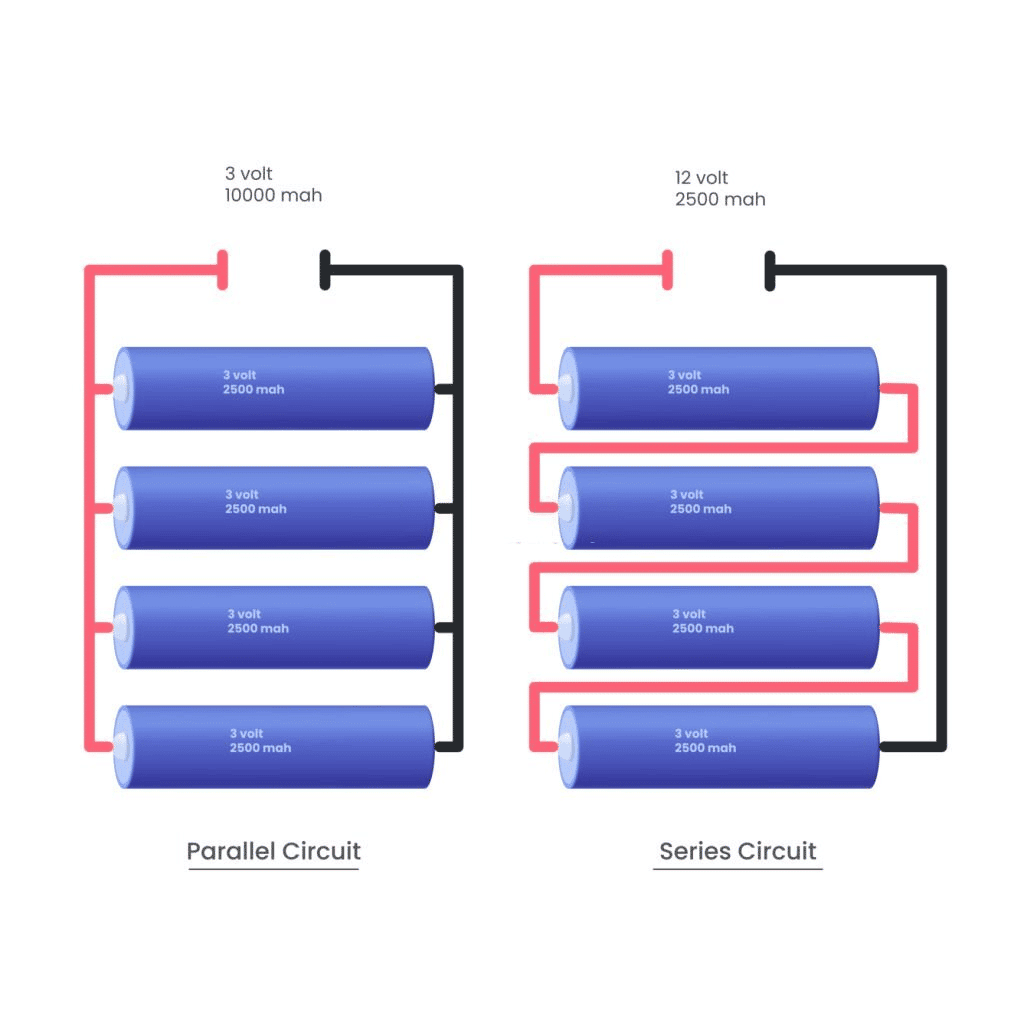
Image Source: iStockPhoto
What Is the Difference Between Batteries in Series and Parallel
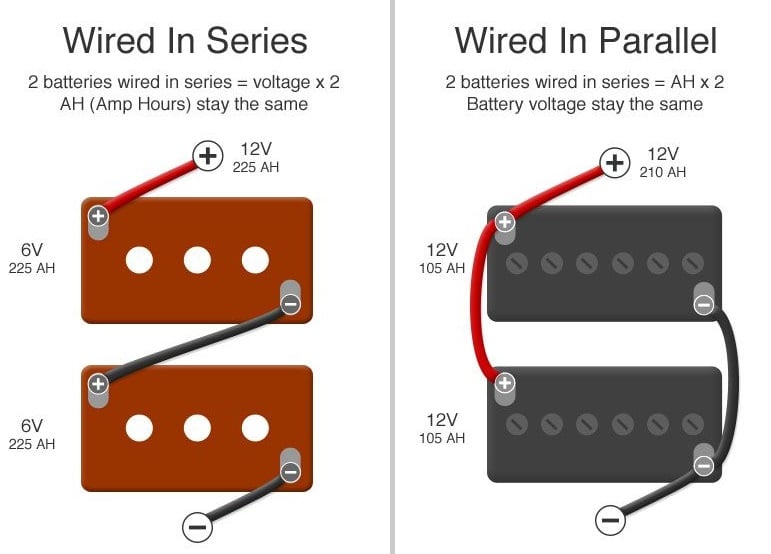
Image Source: Canva
Batteries are a common power source in many electronic devices. There are two main types of batteries: those in series and those in parallel. These connections apply to all battery cells and battery banks. The difference between the two types of batteries lies in the way that the batteries are connected.
- In series, the batteries are connected end to end, so the current flows through one battery and then to the next. This configuration increases the voltage because each battery adds to the one before.
- In parallel, the batteries are connected side by side so that the current can flow through both batteries simultaneously. This configuration increases the current as it tallies the current of the individual batteries.
Battery Series and Parallel Connection Diagram
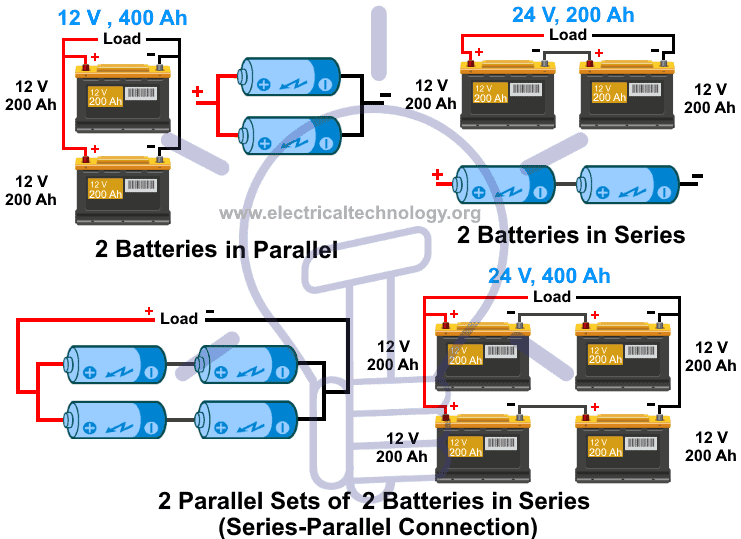
Image Source: Electrical Technology
The diagram shows that we can make a series connection by connecting the positive terminal (+) of a battery to the negative terminal of another battery and vice-versa. The current stays the same in each connection, but the voltage already differs, which can be expressed using the following formula:
V1 + V1 + V3…Vn
Meanwhile, parallel connections are made when the positive terminal of the battery is attached to another positive terminal. The same thing is true with negative terminals connected to other negative terminals. Here, voltage is the same, but the current differs, as it is additive. The following formula expresses this connection.
I1 + I2 + I3…+In
Wiring Batteries in Series
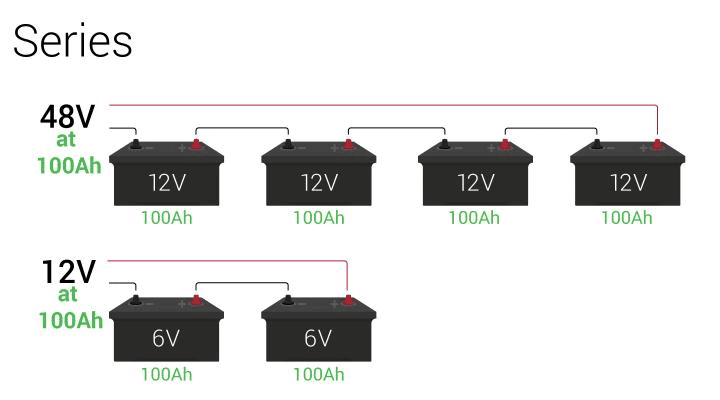
Image Source: NOCO
Wiring batteries in series is a simple process, but it’s essential to do it correctly to avoid damage to your equipment. By wiring batteries in series, you can increase the voltage while maintaining the same amount of current. This can be useful when working with equipment requiring a higher voltage.
In this particular connection, the positive terminal connects to the negative terminal of another battery. The voltages of the batteries add together to create a higher total voltage. For example, two 9-volt batteries wired in series produce 18 volts.
Wiring Batteries in Parallel

Image Source: NOCO
You can connect at least two batteries in parallel. This will increase the capacity while maintaining the voltage. You simply have to connect the respective positive and negative terminals of the two batteries. Basically, the positive terminal goes with another positive terminal, while the negative terminal is with another negative terminal.
With this connection, you are essentially creating one large battery with a higher capacity. The voltage remains the same, but the current adds up.
Wiring Batteries in Series
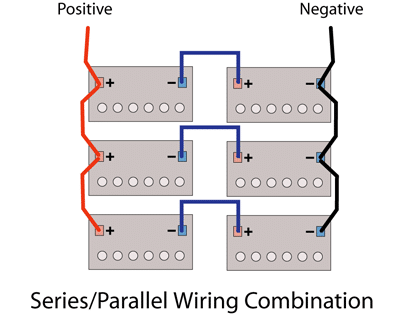
Image Source: Canva
Let’s discuss more about the specifics of battery series connection in the following sections:
How Many Batteries Can I Wire in Series?
Theoretically speaking, there’s no upper limit as to the number of batteries that you can connect in the series. As emphasized, you can’t increase the capacity of these batteries; only their voltage increases. For example, if you connect six 12-volt, 30-Ah batteries, you would get a voltage of 72 volts and a capacity of 30 Ah.
Can I Wire Batteries With Different Voltages in Series?
You are free to connect two batteries with different voltages in a series connection. But doing this would cause damage to the batteries during the recharging and discharging processes. Hence, it is strictly recommended to only connect batteries with similar voltages and capacities. Once a battery gets damaged, the other ones will eventually suffer, too.
What Are The Advantages of Wiring Batteries In Series?
Here are some of the specific advantages of series connections:
- One advantage of wiring batteries in series is that it increases the system’s voltage. This can be useful when powering devices requiring a higher voltage, such as motors.
- Additionally, wiring batteries in series can help increase the system’s capacity, which can be useful for applications that require a longer run time.
- Another advantage of wiring batteries in series is that it can help protect individual batteries from overloading. In a battery series connection, the current is divided evenly among the batteries. This can help to prevent any one battery from being overloaded and damaged.
What Are the Disadvantages of Wiring Batteries in Series?
While series connections may seem like an efficient way to wire batteries, some disadvantages exist.
- The first is that the entire circuit will fail if one battery fails. It is a problem if it happens, especially if you rely on battery power to operate critical equipment.
- Secondly, because the voltage is shared equally among the batteries, each battery will be subject to the same amount of wear and tear. This can shorten the lifespan of the batteries and increase the likelihood of failure.
- Furthermore, the system’s voltage is limited by the voltage of the individual batteries. For example, if you have four batteries wired in series, the voltage of the system will be limited to the voltage of a single battery.
Wiring Batteries in Parallel
Now, let’s discuss the specifics of wiring batteries in a parallel connection:
Can I Connect Two Batteries With Different Ah in Parallel?
Is connecting different amp hour batteries in parallel possible? Yes. You are allowed to connect batteries with two different amp hours (or capacities) in a parallel setup. However, you have to make sure that these batteries are of the same type. Basically, if you use AGM batteries, then only use AGM batteries entirely. Don’t mix other types in the equation; otherwise, issues in discharging could occur.
Can I Wire Batteries With Different Voltages in Parallel?
We all know that parallel battery connections enable the capacity of the system to increase. But at the same time, the voltage of that system stays the same, regardless of how many batteries you attach. Notably, you should only connect batteries with similar voltages in a parallel connection. A 12-volt battery could never go with a 6-volt battery in this setup. Connecting different voltage batteries in parallel is not plausible.
How Many Batteries Can I Wire In Parallel?
Similar to a series setup, there’s no theoretical limit to the batteries that you can include a parallel connection. In fact, the more batteries there are in the circuit, the higher the capacity and the longer the runtime it will have. However, keep in mind that the number of batteries also increases the charging time of the circuit.
What Are the Advantages of Wiring Batteries in Parallel?
When it comes to wiring batteries, there are two main ways to do it – in series or parallel. While both have advantages, wiring batteries in parallel has some distinct benefits.
- For one, it’s easier to wire batteries in parallel than in series. It’s this simplicity that many people prefer using this setup.
- Secondly, wiring batteries in parallel results in less voltage drop, meaning your devices will get a steadier flow of power. Critical equipment and facilities tend to run on parallel battery connections because of their steadfast, long-lasting runtime.
- Finally, wiring batteries in parallel is an excellent way to increase the capacity of your battery pack without having to buy larger, more expensive batteries. It lets you save money without losing efficiency.
What Are The Disadvantages of Wiring Batteries in Parallel?
Here are some of the distinct batteries in parallel problems that you should watch out for:
- The first is that the voltage of each battery will be equal. This can be an issue if you are powering a system that requires a higher voltage. No amount of batteries will increase the voltage of the circuit due to issues of resistance.
- Additionally, wiring batteries in parallel requires a lot of wires. It gets more complicated if you are connecting multiple batteries at once.
- Finally, if one battery fails, it can cause a current imbalance that could damage the other batteries.
12V Batteries in Series vs Parallel
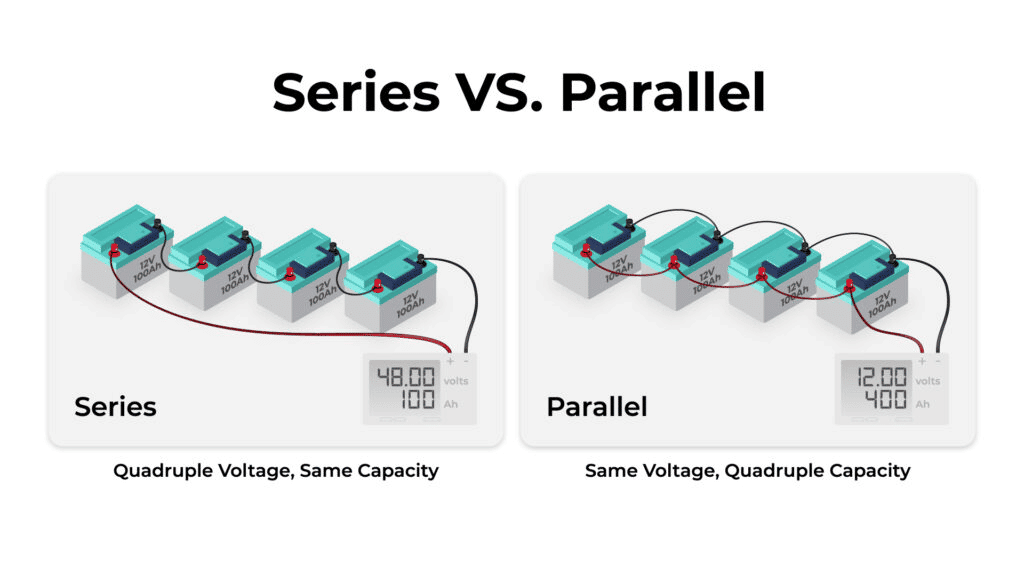
Image Source: Getaway Couple
The main difference between parallel and series connections is how the current flows. In a parallel connection, the current will tread the path of the most minimal resistance, meaning it will flow through the component with the lowest resistance first.
Based on the example above, a 12-volt series connection forces the current to pass from one component to another. Another difference between parallel and series connections is the voltage. In a parallel connection, the voltage is evenly distributed among all components. However, in a series connection, the voltage is added up.
For those who are looking for high-capacity, 12-volt batteries, check the offerings of SunlyPower.
How to Wire Batteries In Series?

Image Source: Getaway Couple
As mentioned, connecting batteries in series will result in an increase in the voltage and not the capacity. For instance, if you want to learn how to connect 4 batteries in series, do the following steps:
- Identify batteries with similar voltages and capacities.
- Next, group the batteries and connect the positive port of one battery to the negative port of another battery. Do this until you can connect all the batteries in the system.
- Finally, connect one cable/link to the negative terminal of the first battery and another cable to the positive terminal of the first battery. The end of these cables will be attached to the device you want to power.
How to Wire Batteries In Parallel?
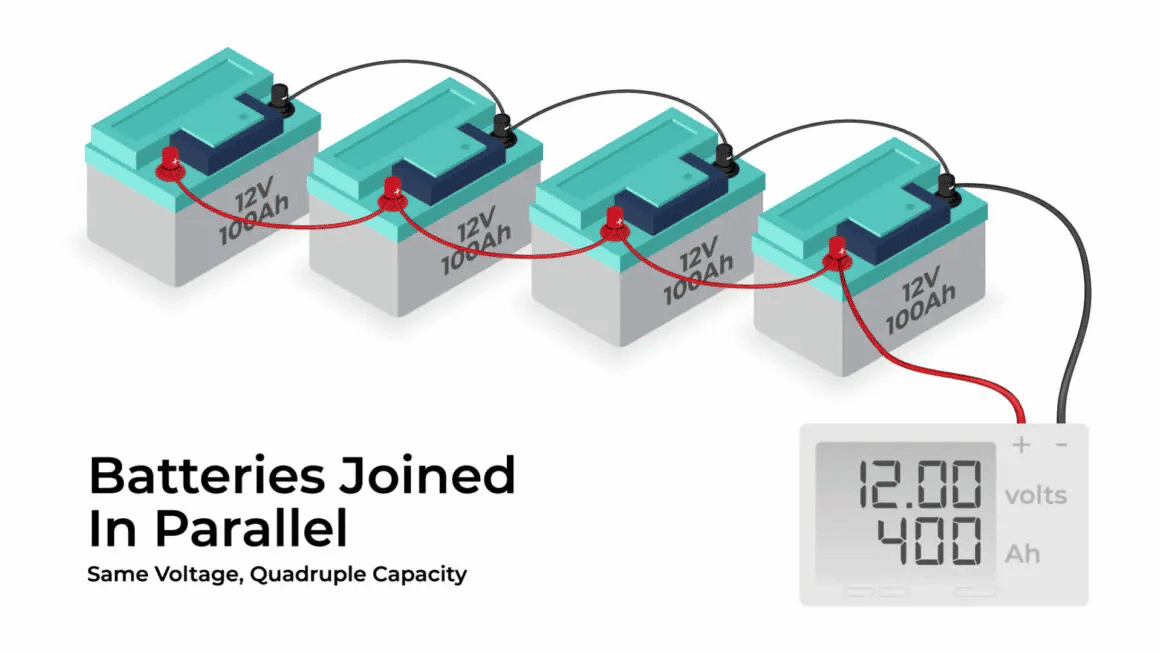
Image Source: Getaway Couple
Alternative, you can also connect multiple 12 volt batteries in a parallel setup. Here, we are going to show how to connect two batteries in parallel.
- Identify batteries that have the same voltage. For example, you can connect a 6-volt battery to a 12-volt battery parallel setup. The capacity may not matter, but it is recommended that these batteries must have the same capacity.
- Connect the negative terminals of the battery together. Do the same to the positive terminals.
- Link the negative and positive wires to the device you want to power.
Is It Possible To Wire In Series and Parallel At The Same Time?
The answer is yes! You can wire in series and parallel at the same time. Doing this would get you the best of both worlds. You increase the voltage while also improving the capacity of the system.
But keep in mind that when doing this setup, you would need at least four batteries with the same capacity and voltage. Furthermore, the batteries should be of the same type. Doing these things prevents complications in the circuit.
Battery Charging in Series vs. Parallel
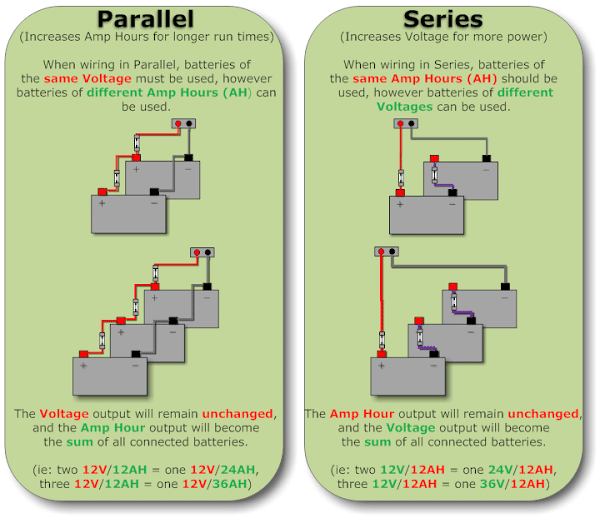
Image Source: Pinterest
Charging batteries in series vs parallel have some considerations.
In actuality, the charging speed of batteries doesn’t matter whether you put them in a series or parallel connection. It still depends on the watt-hours capacity that these batteries have to absorb.
However, if your charger has certain limits, you can configure the setup:
- For instance, if the battery is restricted to 12 volts, connect the batteries in a parallel setup. Link the charger to the system and wait for it to be charged.
- Meanwhile, if the charger comes with variable voltage (24 volts or 12 volts), a series connection for the batteries is better. A 24-volt charger can charge faster. And you can take advantage of this charger if you have a series connection.
Hooking Batteries in Series vs Parallel
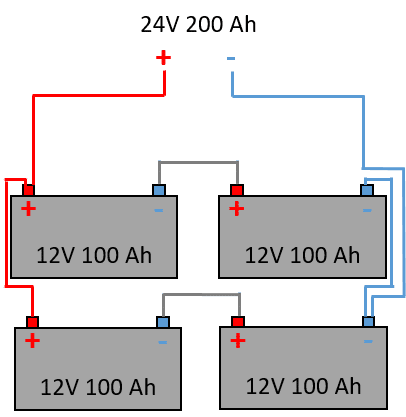
Image Source: Pinterest
Hooking up batteries in series vs parallel have certain advantages and downsides:
- In a series connection, you link the positive terminal to the negative terminal of two or more batteries. Doing this doesn’t increase their capacity, only the voltage. This setup is advantageous in applications that require high-voltage systems. On the flip side, you can’t lower the voltage of a series connection unless you use a converter.
- A parallel connection requires linking terminals with a similar charge to one another. With an increased capacity, the runtime is optimized without compromising the voltage. But then again, the lower voltage means that its application is limited.
Is It Better to Wire Batteries in Parallel or Series: Summary
Both series and parallel connections offer specific advantages and disadvantages. When done correctly, running batteries in series vs parallel setups offer safe, continuous power supplies.
Of course, the integrity of these mechanisms lies on the battery you choose. Hence, you should get high-quality batteries from reputable manufacturers, such as SunlyPower.

